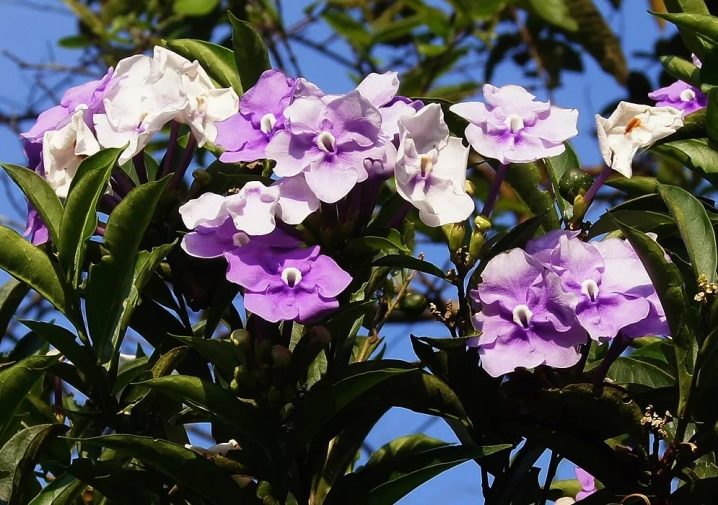The best varieties and hybrids of balsam
During its long history, the popular flower has changed its role several times. If earlier the "light" or "Vanka wet" was mainly a houseplant, now it is in demand by flower growers, first of all, as an annual flower bed. However, this does not interfere with the onset of autumn to move it indoors and enjoy the indomitable bloom of a charming "fire", which again becomes indoor.
Our grandmothers' choices were limited to scarlet and crimson varieties, but modern balsams provide numerous hybrid lines with truly amazing colors, different types of flowers and bush shapes.
Terry balsam varieties of the Athena series ("Athena")
Waller's most popular line of multi-petalled balsam is called Athena. This hybrid series combines plants with semi-double flowers, resembling small camellias or roses in half-release. The series includes seven different colors, which, in turn, can be divided into three groups.
Balsams of red shades
Lovers of the classics can choose the monochromatic Athena Red of carmine-red color, similar to the grandmother's "light". And flower growers who prefer exotic will not be able to pass by the amazing Athena Coral Pink balsam. Its snow-white terry flower is as if wrapped in a weightless coral net or painted by an invisible artist.
Another, no less interesting hybrid Athena Red Flash can also be found on sale under the name "Strawberry with Cream". In its petals, white and scarlet are present in equal proportions, and such a color, indeed, resembles an appetizing dessert.
Balsams of pink shades
Balsam Athena Bright Purple blooms solid flowers of a bright crimson color, a similar, not variegated, color is well suited for mixed plantings.
The popular hybrid Athena Appleblossom surprises with delicate shades of pink and white inflorescences of a characteristic color, referring to the blossoming of apple orchards in May (“appleblossom” from English means “apple tree color”).
Balsams of orange shades
The petals of the Athena Orange hybrid are distinguished by a fiery orange color, while the Athena Orange Flash balsam has small white blotches on the orange background.
Balsam Athena Bright Purple. Lyudmila Svetlitskaya Balsamin Athena Orange. Lyudmila Svetlitskaya Balsamin Athena Red. Lyudmila Svetlitskaya
Other varieties and hybrids of balsam
It is very difficult to pass by the Mosaic series of hybrid balsams, whose color consists of the finest lines and veins of varying intensity. The series combines four colors: orange, red, pink and purple. Usually, the color of their petals is more intense along the edge, and closer to the center it becomes almost white.
In a scientific way, flowers of this type are called "chimeric". A similar effect is achieved due to the fact that balsam cells of different colors are intertwined in the tissues of the petal, which surprisingly do not mix with each other.
Colorings of the chimeric type also have a series of "Pikoti" with a dark rim along the edge of the flower, as well as a variety series with the telling name Star ("Star"). The latter has characteristic expressive patterns in the form of a white star in the middle of a bright flower. But in the lines Accent, Super Elfin, Salmon Splash and Impreza, a characteristic star or butterfly in the center of the flower has an expressive dark color against the background of light-colored petals.
Among the named hybrids, I would especially like to mention Super Elfin XP Salmon Splash with a very rare peach coloration and a scarlet star in the center. And also incredibly elegant Impreza Cherry Splash with an expressive red "butterfly", "squatting" on the snow-white petals.
Massive balsam Tumbler is declared as an ampelous variety. However, you need to understand that plants do not form classic cascading cascades. And almost any balsam can be made semi-ample by planting it close to the edge of the container.
This series is characterized by dense branchy bushes of the correct spherical shape. This balsam grows very voluminous bushes, and at a height of 30 centimeters, the width of the plant can reach 70 centimeters.
 Balsam "Mosaic". Lyudmila Svetlitskaya
Balsam "Mosaic". Lyudmila Svetlitskaya
Types of Smithyanta
There are 9 species of Smithyanta registered in the genus, they can be seen in the photo. For more variety, several decorative varieties have been bred.
Smitiante striped. This decorative perennial forms a compact shrub 30-40 cm high. Its straight, succulent shoots rise above the fibrous root system covered with scales. Heart-shaped leaves are opposite. Their length reaches 18 cm. The velvety green surface is covered with a pattern of burgundy veins. Reddish-orange flowers with a long tube and rounded, slightly bent petals bloom on the peduncle. The pharynx of flowers is colored bright yellow and covered with burgundy dots.
 Smithiante striped
Smithiante striped
Smitiante cinnabar red. The plant is more compact in size, its height does not exceed 30 cm. Large velvet leaves up to 15 cm long are colored dark green. They are covered with many burgundy hairs. A pyramidal inflorescence about 25 cm high rises above the bush. It consists of cascades of orange bells. Flowers form from spring to autumn. By the end of flowering, their number can reach up to one hundred units.
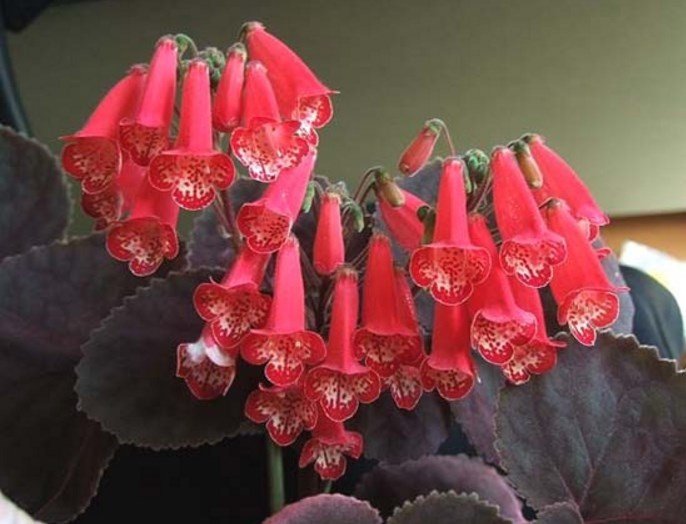 Smitiante cinnabar red
Smitiante cinnabar red
Smitiante multiflorous. A soft herbaceous perennial with a height of 25-30 cm, it is distinguished by a lighter color of leaves. The leaves are heart-shaped and have short teeth towards the end. Creamy or snow-white flowers are located in loose clusters of inflorescences. The length of the bud tube is 4 cm. Flowering occurs in the summer months.
 Smithiante multiflorous
Smithiante multiflorous
The early spring hybrid variety is popular. Its flowers are collected in a beautiful, cascading inflorescence. Delicate buds have a light pink tube, yellow throat and white, covered with red dots, petals.
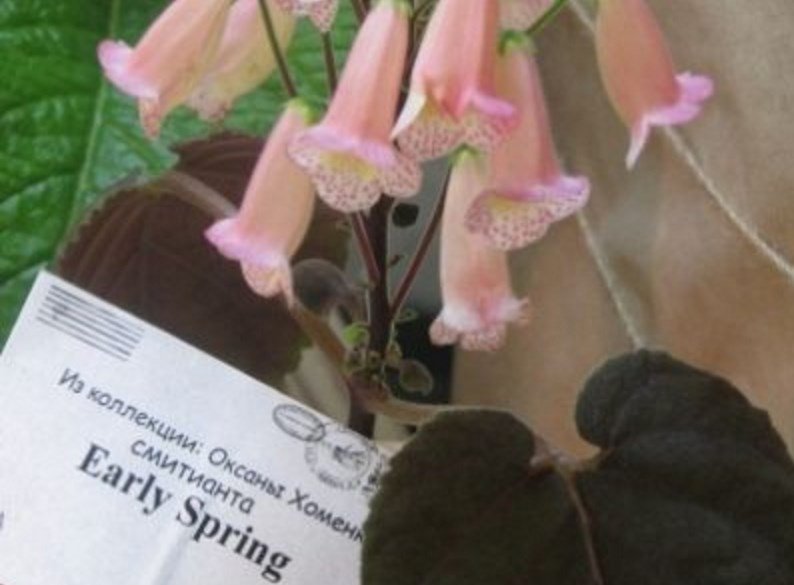 Smithiante early spring
Smithiante early spring
Smitiante zebra. This species forms a soft growth up to 60 cm high. The wide-oval foliage is dark green and covered with burgundy streaks along the veins. The leaves are densely pubescent, their length is about 15 cm. Above the bush, loose inflorescences of scarlet flowers bloom. The pharynx of each bud is colored orange and covered with many red or burgundy dots.
 Smithiante zebra
Smithiante zebra
Smitiante hybrid. An upright perennial with heart-shaped, dark green leaves. At the tops of the shoots and from the axils of the leaves, paniculate inflorescences bloom. They consist of many scarlet, orange or cream flowers on elongated pedicels.
 Smitiante hybrid
Smitiante hybrid
The Prelude variety is very popular. Its flowers have a purple tube. Inside, it is painted in a yellow shade with many scarlet specks. The white edges of the petals are covered with pink streaks and dots.
 Smitiante Prelude
Smitiante Prelude
Home care
Home care for a flower is simple. All that is needed is to provide the plant with enough light, maintain a suitable temperature in the room, water it correctly and replant it on time.
The flower must be provided with a large amount of diffused light with the least amount of direct sunlight. Spathiphyllum can also grow in the shade, but the quality of flowering will deteriorate and the decorative characteristics of the leaves will decrease. Spathiphyllum varieties Alfetta and Bellini thrive when placed in the shade.
Note! Under the influence of active sunlight, color loss and even thermal burns on the leaves can occur. In summer, when the plant blooms, the optimum temperature for it is -22-24 ° C °
In winter, when it is in a dormant period, the air temperature should not exceed + 17 ° C
In summer, when the plant blooms, the optimum temperature is -22-24 ° C °.In winter, when it is in a dormant period, the air temperature should not exceed + 17 ° C.
In summer, the flower is watered every 2-3 days, in winter - no more than once a week. It is also worth ensuring the humidity in the room is at least 40%, spraying the leaves and carrying out preventive sponge wiping with warm water.
Important! Watering and spraying should be carried out only with purified and warm (+30 degrees) water. Planting requires special soil, which can be purchased at a flower shop.
You can also prepare the soil yourself. The usual composition for a flower should include peat, leafy earth, humus, sand, crushed tree bark and charcoal
Planting requires special soil, which can be purchased at a flower shop. You can also prepare the soil yourself. The usual composition for a flower should include peat, leafy earth, humus, sand, crushed tree bark and charcoal.
When planting spathiphyllum in open ground, it is necessary to provide the plant with shelter from direct sunlight and timely watering. If there is a risk of morning frost, the plant must be returned to room conditions.
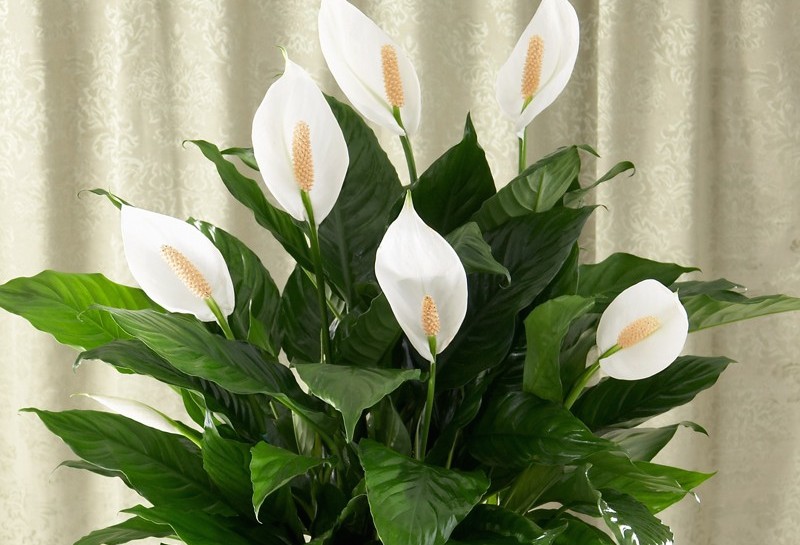
Flowering Spathiphyllum
Pruning is carried out after flowering has ended. All peduncles that have already wilted are cut off. Pruning is also done as needed if there are limp or dry leaves.
Smitiante: flower description
Smithiante was first bred in America in 1840. Its discoverer was the breeder Matilda Smet, in whose honor, by the way, this flower got its melodic name. The homeland of this pretty flower is South America, but some researchers claim that it grows well in Central America. By the way, Smithianth flowers are a rather small genus, which, of course, will go into the hands of those people who find it very difficult to determine the choice of which variety to give their preference to. In total, it unites only eight plant species, which, compared to some of the more numerous genera, is simply nothing.
Smitiante is a herbaceous plant and therefore not too tall. It has straight stems covered with soft fluff. In length, they do not reach more than seventy centimeters, but sometimes taller specimens are also found.

Smitiante: photo of a flower
The roots of the Smitiante flower are scaly, and the shoots are very straight and grow almost perpendicular to the ground. The leaves, by the way, like the stems, are pubescent and very pleasant to the touch. Moreover, they also look very pretty. Their color can be described as dark burgundy interspersed with green. They grow completely asymmetrically in relation to each other, and their shape is similar to an oval or an inverted egg.
As for the flowers, in their shape they very much resemble ordinary bells, however, compared with them, the buds of Smitanta are much longer and elongated. On peduncles, they are combined into small inflorescences, which contain from two to five flowers. And, of course, their coloring is very interesting. The fact is that it is completely unstable and varies greatly from variety to variety. However, flowers are usually red, orange, pink, or even white.
Talking about the size of Smithyanta, it is also difficult to come to any average value, since there are species among which there are really huge specimens, as well as those among which only dwarf varieties can be found.
By the way, it is also quite important that this flower has a rather long and pronounced dormant period, the beginning and end of which is simply impossible not to notice.As soon as the bell buds fade, the rest of the flower (exclusively the upper one) also begins to gradually die off, and after a week there is nothing left of a beautiful small bush, except for the root sleeping under the ground
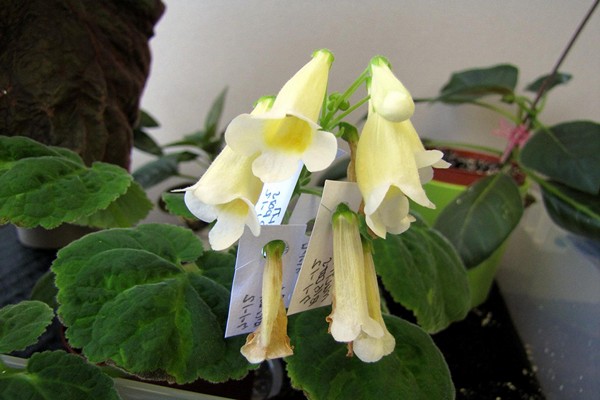
Smitiante: photo of a flower
Types and varieties of springnik (erantis) with photos and names
Several types of spring plants are grown in the culture, but only a few of them are very popular.
Erantis winter (Eranthis hyemalis), or winter spring, or winter spring
This species comes from southern Europe. In the wild, it prefers to grow on mountain slopes and in forests under deciduous trees. Underground rhizomes have nodules. The leaf plates are basal. The height of leafless peduncles can reach 15–20 centimeters. Under the six-petaled yellow flowers are very spectacular dissected bracts. Flowering begins in the last days of winter, with flowers rising above the snow cover. Leaf plates grow later than flowers. This spring bloom fades in the last days of May or the first days of June, after which the aboveground part of the bush dies off. This species has a high winter hardiness. Cultivated since 1570 The most popular varieties:
- Noel Hey Res. It has double flowers.
- Orange Glow. This Danish variety was born in a Copenhagen garden.
- Pauline. This garden variation was bred in the UK.
Erantis Siberian (Eranthis sibirica)
Under natural conditions, it can be found in Western and Eastern Siberia. The compact bush is tuberous, when it finishes blooming, it dies off in a short time. Single straight shoots are not very tall. On the bush there is only one basal leaf plate of a palmate-split shape. Single flowers are white. Flowers bloom in May, and the growing season for this plant ends in June.
Eranthis cilicica
In the wild, you can meet in Greece and Asia Minor. This species came to European countries only in 1892. The height of the bush does not exceed 10 centimeters. In comparison with the winter spring in this species, the flowers have a large size. Deep and finely dissected leaf plates have a purple-red color. Stem leaf plates are also dissected into narrow lobes. In comparison with wintering erantis, the species begins to bloom half a month later, but its flowering is not so active. This plant is moderately hardy.
Erantis long-legged (Eranthis longistipitata)
His homeland is Central Asia. The bush is very similar to the winter spring, but it is not so high. Its height is only 25 centimeters. The color of the flowers is yellow. Blooms in May.
Eranthis tubergenii
This hybrid plant was created as a result of crossing Erantis winter and Kiliya. The bracts and nodules in this species are larger, while the flowers do not have pollen, and they do not have seeds, so the plant blooms for a relatively longer time. Popular varieties:
- Guinea Gold. The height of the bush is from 8 to 10 centimeters. Dark yellow sterile flowers reach 30–40 mm in diameter. They are surrounded by bracts of a bronze-green color. This plant was bred in 1979 in Holland.
- Glory. The color of large flowers is yellow, and the leaf plates are light green.
Eranthis stellata
The homeland of this kind is the Far East. The height of the bush is about 20 centimeters. Such a herbaceous perennial plant has 3 basal leaf plates. The leafless shoot bears a white flower, the petals of which are painted in a violet-gray color from below. Prefers to grow in shady areas. Flowering begins in April.
Erantis pinnatifida
This Japanese species has white flowers, yellow nectaries and blue stamens. This species is quite hardy, but experts advise growing it in a greenhouse.
Rare species
There are several rare species of this flower.
Adorable
Herbaceous perennial 40 centimeters high. Leaves, pubescent, rounded. Bell-shaped tubular flowers, red-yellow, spots on the petals. Flowers are 4 centimeters long. Blooms from spring to autumn.
Cinnabar red
Dark green leaves, 25 centimeters, with burgundy hairs. Velvet texture. Red bells, 4 centimeters long, gathered in a pyramidal inflorescence. Blooms from March to October. At the end of flowering, about a hundred flowers are formed on one plant.
Shiny
Bright green leaves, rounded, narrowed at the tips, covered with fluff. The bells are short, red-orange in color; in the lower part, the bell is yellow with contrasting, clearly distinguishable red spots.
This flower is the rarest one. It can only be found in collections.
Multi-flowered
A fleecy plant, 30 centimeters high. This perennial has heart-shaped, light green leaves, with denticles along the edges. The buds are white or creamy, 4 centimeters long. It blooms in summer and is used to create hybrids.
Point
Perennial decorative, 30-40 centimeters in height. Rounded leaves are purple in color, 16-18 centimeters long. Long bells expand towards the tip. The petals on the extended part are small, rounded. Bells are orange-red, yellow petals with blurred red dots.
Home care
The smithiant flower requires not complicated, but careful care. Compliance with the temperature regime, timely watering and proper lighting. Subject to these rules and periodic feeding, the flower will delight with abundant flowering.
Lighting
Best placed on the east or west side. He loves light, but not direct sunlight. There will be insufficient vegetation on the north side. A flower standing on a south-facing window will require darkening: fabric blinds or tulle.
It is the right lighting, not feeding, that is the stimulant for good flowering. If the plant does not bloom, it must be rearranged to a different location, without direct sunlight.
Watering
During the growing season, it is necessary to water abundantly. The flower loves moist soil, but not wet. Care must be taken so that moisture does not stagnate in the pot. It is best to water with settled water from below. The leaves of the flower should not be wet, this will ruin the appearance. During the dormant period, after the dying off of the ground part, watering should be reduced, only occasionally moistening the ground.
Temperature
The plant loves moderate heat. During the flowering period, the temperature must be kept within 25 ° C. After the upper part of the flower dies off, reduce the temperature to 20 ° C, but not below this mark.
Also, the plant must be provided with suitable moisture. Dry air causes the tips of the petals to dry out and curl up. To maintain humidity, the flower pot is placed in a tray with wet pebbles or expanded clay. The water should not come into contact with the bottom of the pot, otherwise the root system will die.
Priming
Smitiante loves peat soil. It must allow air and water to pass through. The soil can be prepared independently by mixing sod and leafy soil, peat and coniferous soil. Moderate soil moisture, without drying out and excessive moisture, will be an ideal place for this flower. Additives can be used with the substrate: vermiculite or sphagnum moss. The potting mix should be light and loose.
Reference! For smithians, you can buy ready-made soil mixture "Violet" or "Begonia".
Pot
The pot should be shallow, as the plant has a superficial root system. Place a thick drainage layer at the bottom, made of expanded clay or foam. The smithyanta can also be placed in baskets or pots and hung on the window. After a dormant period, the plant is transplanted into a new pot.
Top dressing
During the flowering period, from March to September, the smithiante needs feeding.Fertilizer can be used universal, diluted with water so that the concentration is 2 times lower than the norm. During the rest period, feeding is not carried out.
Pruning
The Smithian needs to be plucked or trimmed regularly. Cutting off the top allows new leaves to grow, and the flower begins to grow to the sides. Also promotes abundant flowering.
Home care for ifaeon
In natural conditions, flowering in Ifeion is observed at the end of the spring period. After this, the plant begins a dormant period. At the beginning of the autumn period, young shoots appear at the plant. In this regard, it is better to postpone the purchase of bulbs intended for planting until the end of summer. If the bulbs are stored longer, then they may dry out.
Earth mixture
Suitable soil is light and should contain a lot of leaf humus. Do not forget to make a good drainage layer at the bottom of the container. Plant the onion, burying it 5 centimeters into the soil. Drizzle with lukewarm water. It is recommended to plant several bulbs at once in one container. The first flowering is not as abundant as the subsequent ones, because the bulbs gradually grow.
Flowering features
Flowers similar to stars consist of 6 petals. They have a very delicate and spectacular color, and with abundant flowering, an extremely picturesque picture is created. For the entire flowering period, 1 bulb is capable of throwing out several peduncles. If several bulbs were planted in a container at once, then flowering can last about a month or even longer. When the plant fades, all the leaves dry out.
Illumination
It is recommended to place it in a sunny place, and therefore it is better to choose a south-facing window. In autumn and winter, the ifeion should also be placed in a well-lit place, otherwise the foliage may lie down.
How to water
Watering should be done regularly, but not very abundantly. Between waterings, the top layer of the substrate should dry out. Irrigation water can be used with any hardness.
Fertilizer
The first time the plant is fed at the end of winter. Before flowering begins, you need to have time to fertilize the soil 2 or 3 times. For this, any fertilizer for indoor plants is suitable. After flowering begins, fertilizing the soil should be stopped, and the flower should also be watered abundantly.
Dormant period
After the end of flowering, the foliage begins to turn yellow and dry. From this time on, the plant is not watered, it begins a dormant period that lasts until the end of the summer period. Dried leaves must be carefully cut off. During the dormant period, the soil must be occasionally moistened in order to avoid drying out of the bulbs. In this case, the flower pot itself is recommended to be rearranged in a fairly dark and cool place. The appearance of new leaves occurs at the beginning of the autumn period. The pot is moved to a well-lit place and the plant is again watered.
Reproduction methods
It can be propagated by dividing the bulbous nest, as well as by seeds. The division of the bulbs and their transplantation is carried out 1 time in 3 years. Daughter bulbs bloom in the 2nd year. Full maturation of seeds occurs 6 weeks after the beginning of the flowering period. A flower grown from seeds begins to bloom only at 3 years of age.
Reproduction of the Syngonium
Liana can be grown from seed, the process takes too long, so this method is used only in nurseries. At home, it is easier to propagate the plant with apical cuttings, lateral shoots, the length of which is at least 10-15 cm. The shoot should have about 2-5 internodes and air roots. Cuttings can be rooted in water or a substrate consisting of peat, sand and sphagnum moss (in equal parts).
Home rose: description with photo, planting and care, growing at home
Syngonium can be propagated at any time of the year, but it is better in spring, when the mother plant is actively growing.For rooting, you need to take settled water, for disinfection add half an activated carbon tablet to it. The liquid should be changed periodically to avoid the appearance of a cloudy film on the surface. How to root the cutting in the substrate:
- sprinkle the tip of the shoot with a growth stimulant, place it 1, 5–2 cm into the soil, moisten;
- cover the container with a transparent bag so that air flows inside;
- put the container in a room where the temperature always remains at 25-27˚С;
- after the formation of roots, the cuttings must be transplanted into pots and watered.
For the first time, a pot with a diameter of 7-9 cm will be enough. When planting a lump of earth from the cutting, it is not necessary to remove it. It is necessary to plant and grow seedlings in the same way as the mother plant, there are no differences in care either. If the Syngonium is not a bush, it is advisable to immediately install a support, wrap it with coconut fiber or sphagnum moss. When growing in a hanging planter, no support is required.
Note! To create a variegated composition, you can plant several cuttings from different varieties in one pot.
Syngonium refers to unpretentious indoor plants, it is easy to care for it, but important details should not be overlooked - monitor humidity, temperature, provide normal lighting and apply fertilizers in a timely manner. Liana has a positive effect on the mental state of a person, saturates the air with oxygen, but the main advantage of the Syngonium is incredibly beautiful leaves.
Features of species and varieties
Brunfelsia grandiflorum
A fairly common variety, with large and beautiful flowers. The blooming period of large-flowered brunfelsia begins in March and ends in October. Many people note the pleasant aroma of this variety and the exquisite appearance of the flowers themselves.
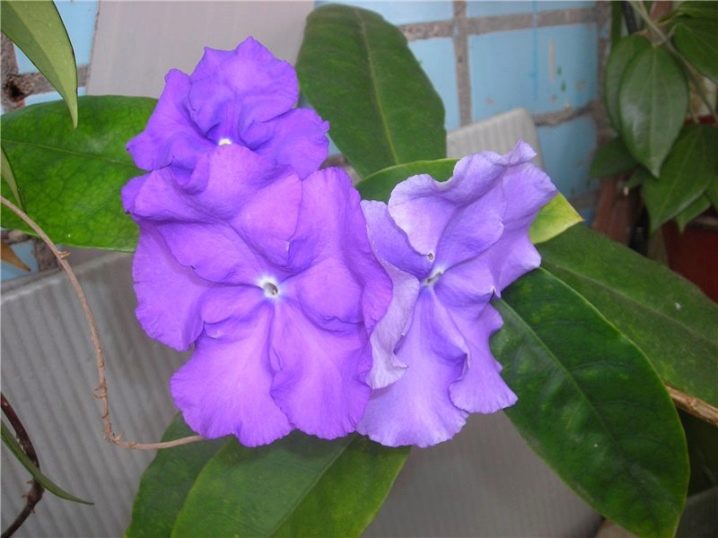
Brunfelsia americana
If you want a large and beautiful flower in your home or garden, then feel free to choose a variety of brunfelsia called americana. It grows up to six meters in height and will delight you at night with its pleasant and tasty aroma.
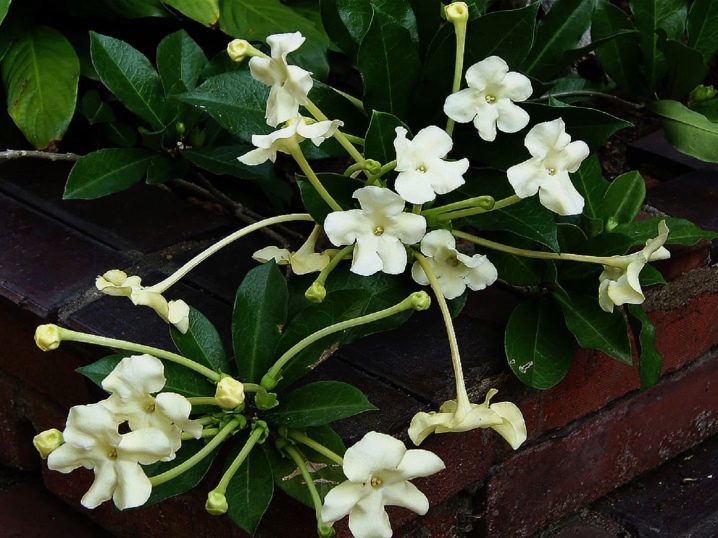
Brunfelsia small-flowered
For indoor breeding, the type of brunfelsia small-flowered has become very popular. This species is less whimsical to the environment and adapts well to the room atmosphere. Also, the little-flowered brunfelsia is distinguished by longevity.
Small-flowered brunfelsia has many varieties, for example, it is dark purple, light purple and violet-flowered.

Brunfelsia "Isola"
This is one of the new hybrid varieties, the varieties Brunfelsia Americana and Brunfelsia Grandiflora were used for its breeding. Has a pleasant aroma and attractive appearance. Flowers are often elongated and elongated, cream or purple in color. It blooms slowly throughout the summer.
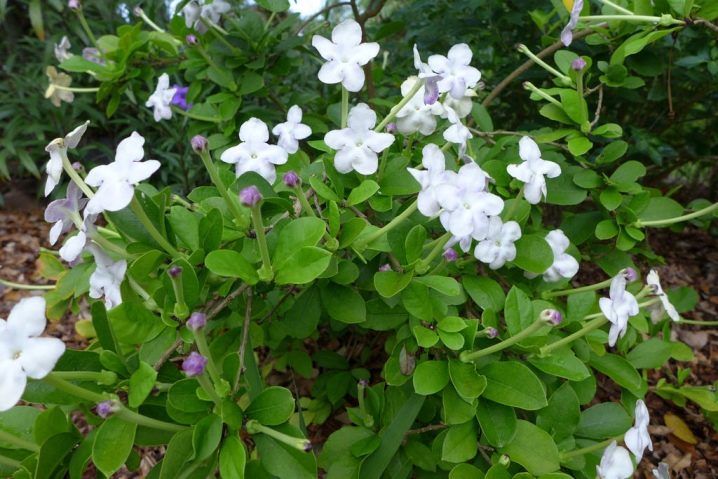
Brunfelsia "Nitida"
The unusual arrangement of flowers gives this species uniqueness and exclusivity. The flowers not only look interesting, but also have a delicate and pleasant scent.
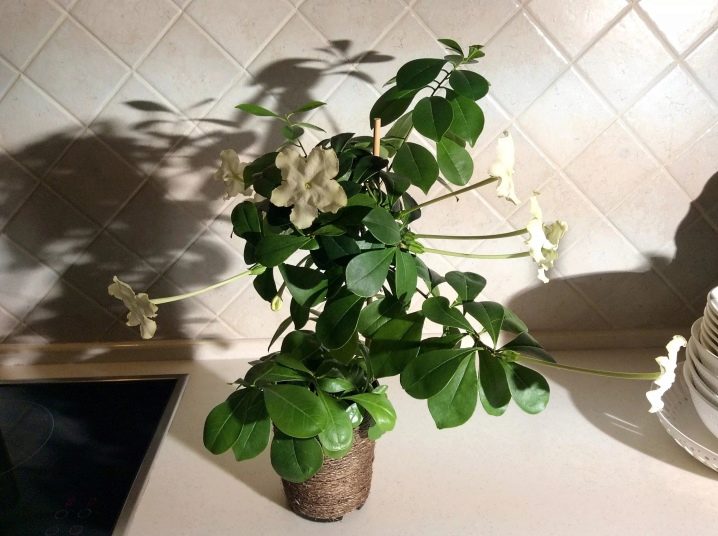
Brunfelsia AS Monaco
This variety is a medium-sized shrub, approximately 2 meters high. The flowers are white. Also Brunfelsia "Monaco" is not deprived of its characteristic pleasant aroma.

Brunfelsia "Laktea"
Or "Lady of the Night" - the flower got this name because of its pleasant smell at night. Brunfelsia "Laktea" is able to fill the space around itself with a delicious and unforgettable aroma. But during the day, its aroma is almost invisible.

Brunfelsia "Uniflora"
It is a large and massive bush with beautiful small flowers (2.5 cm in diameter). In the process of flowering, the petals are colored blue or purple, but in the end all parts of the bud turn white.
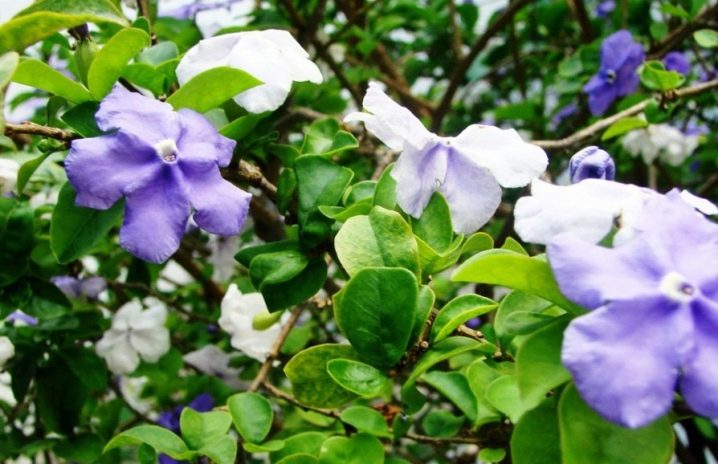
Brunfelsia "Latifolia"
It attracts with its unusual leaf shape (variegated shape). Quite compact, grows no more than one meter in height. It blooms throughout the summer, namely from May to September. The flowers are rich in white and purple.
